Sonja Wehsely, executive vice president CEECA Siemens Healthineers: The MAGNETOM Flow is the first plug-and-play 1,5T MRI scanner ever and can improve access to healthcare

Siemens Healthineers, the medical technology branch of the German multinational, recently launched its newest MRI scanner, the MAGNETOM Flow, during an event held in Bucharest on April 24. Featured in one of the panels during the event, Sonja Wehsely, executive vice president CEECA Siemens Healthineers, highlighted the strengths of the new scanner.
Wehsely, who has been with Siemens Healthineers for over 7 years, has been talking about AI in healthcare and imaging for years. She says her personal goal is to improve the lives of 8 billion people by easing access to healthcare services.
During the panel, Wehsely underscored the pivotal role of technology in enhancing healthcare services. She mentioned that AI, in addition to supporting doctors, plays a crucial role in healthcare sustainability, a concept that extends beyond energy conservation. She further emphasized the importance of retaining healthcare professionals in Romania for long-term service provision.
The Siemens Healthineers executive VP also noted that innovation leads to better outcomes and lower costs in healthcare. For her, innovation is not only just about funding. Instead, different mindsets can be used to better tackle emerging needs. New technology, such as the easy-to-use MAGNETOM Flow scanner, can come to ease the lack of radiology specialists, for example. The massive and expensive conventional MRI machines, which in the past required large funds, can also be supplanted by the plug-and-play MAGNETOM Flow, can also travel between locations if needed. The scanner is also less than 2 meters in height, 24 square meters in footprint and does not need a quench pipe.
Sonja Wehsely also sat down with Romania Insider to answer a few more questions regarding the innovative scanner, the first of which will be installed at the Dorna Medical Center in Borsa, Maramures, northern Romania, in June 2024.
How is the MAGNETOM Flow different from other systems like the MAGNETOM Free.Star?
The important difference is that it uses a field of 1.5 Tesla but with almost no helium. Normally, an MRI has about 1,000l of helium, which is costly and can cause some problems. If the cooling does not work properly, you have to put in the entire amount of liquid helium again. The MAGNETOM Flow uses only 0.7l of liquid helium, like a small bottle. It is much more cost-efficient, much more sustainable, and it is much easier to install. With a normal MRI, the room preparation is much more expensive and has to have an area where you can let out helium. You don’t need that here, you can put this MRI everywhere, plug-and-play, and that is the first MRI where this is possible.
The previous MAGNETOM Free.Star scanners could be fitted into containers for greater accessibility. Do you have the same plans for this system?
That depends, because, related to the sustainability topic, you should always use what you need where you need it. The question is, if you have something in a container, wouldn’t the MAGNETOM Free.Star be the better choice for that? We can always discuss this, and of course, the use cases are always changing. The MAGNETOM Flow here is not only one of the first ones installed in Romania and the entire Europe, but it also represents a scientific partnership. We always look into how the technology develops. MRI is a 40-year-old story. We started from nothing, and now a lot has changed. I cannot say that the MAGNETOM Flow won’t be fitted into mobile containers, but I don’t see the necessity at the moment. If it comes up, we will work on that as well.
When it comes to MRI technology in Romania, the number of scans being done is quite low in the southern counties. Do you have plans to install the machine in the southern regions of the country?
That is a decision Romania has to take, I can only recommend it. This product gives more access to healthcare because you do not need the highly-specialized room preparation, you could put it everywhere. I hope this one machine is just the start because the MAGNETOM Flow scanner could leverage this way of diagnosis a lot, especially in rural areas.
Over 70% of MRI machines in Romania are in private networks. Are you also talking to public hospitals and other public institutions?
We are also talking with them as well, and I am very happy that the secretary of state of the Ministry of Health was here today. That is, of course, a decision of the government, if there will be a tender or not. I can only highly recommend it, because it gives people the opportunity to get the best diagnosis possible.
*This Healthcare Trends article is supported by Siemens Healthineers.












